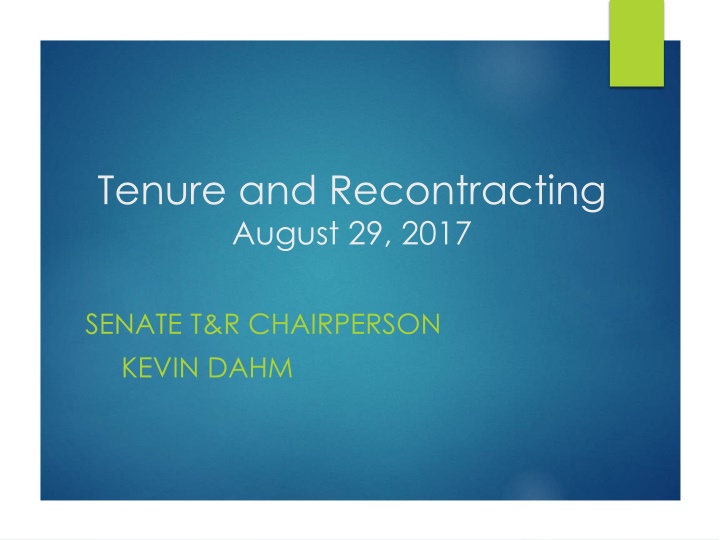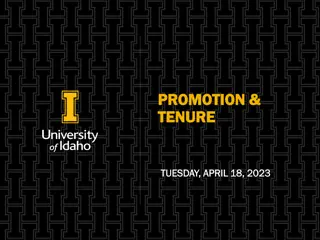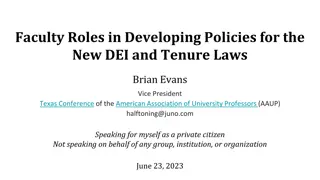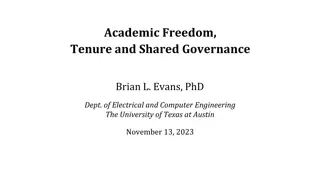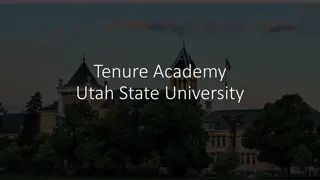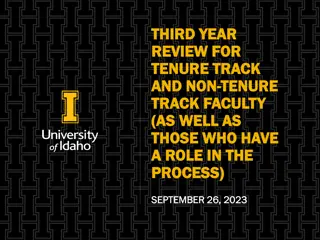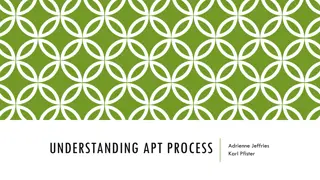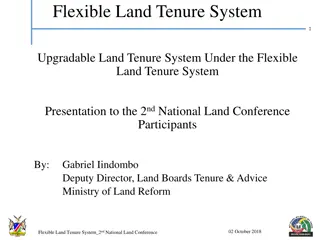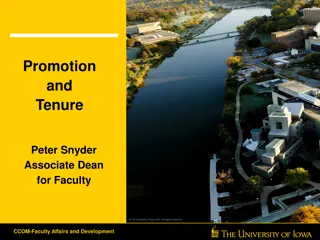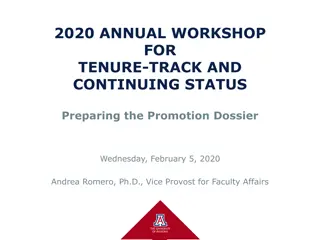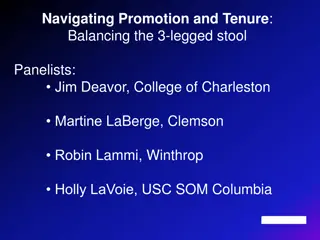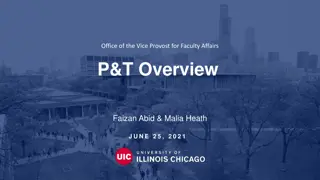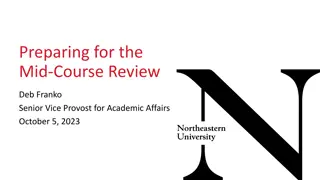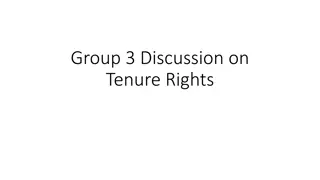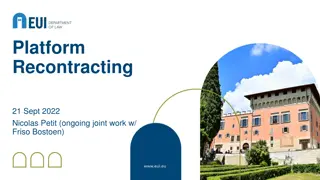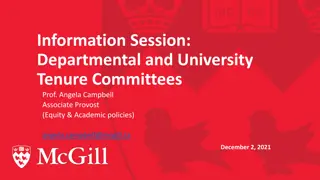Tenure and Recontracting Process Overview
Detailed overview of the tenure and recontracting process for faculty members at a university, including deadlines, review tasks, committee responsibilities, and application procedures.
Download Presentation

Please find below an Image/Link to download the presentation.
The content on the website is provided AS IS for your information and personal use only. It may not be sold, licensed, or shared on other websites without obtaining consent from the author.If you encounter any issues during the download, it is possible that the publisher has removed the file from their server.
You are allowed to download the files provided on this website for personal or commercial use, subject to the condition that they are used lawfully. All files are the property of their respective owners.
The content on the website is provided AS IS for your information and personal use only. It may not be sold, licensed, or shared on other websites without obtaining consent from the author.
E N D
Presentation Transcript
Tenure and Recontracting August 29, 2017 SENATE T&R CHAIRPERSON KEVIN DAHM
Goals of the Review Process Make an accurate assessment about candidates' long term value to the university community Provide clear and accurate feedback to candidates in each review cycle
Resources Tenure and Recontracting MOA and forms available at: https://sites.rowan.edu/academic- affairs/aftlocalagreements.html
Deadlines For second year faculty, the deadline for your DEPARTMENT committee to finish its work is OCTOBER 30. Department committee will probably want about two weeks.
T&R Review: Department Tasks Department approves criteria Department elects the Dept. T&R Committee Candidate works with Department T&R Committee to prepare application Department T&R Committee reviews and appraises the application, then votes Department T&R Committee members sign the summary Signed summary becomes a part of the application package reviewed by the Senate
T&R Review: Senate Committee University Senate T&R Committee Chair is elected and committee members are selected Representatives from faculty of all colleges, as well as professional staff AFT representative ensures all proper procedures are followed
Senate Committee Review Candidate submits one original application and supplemental folder and one PDF application T&R Committee meets to discuss each candidate s packet in detail Senate committee votes and writes a summary letter(s) including numerical vote Senate committee chair and candidate sign summary evaluation letter Signed letter becomes part of the packet forwarded to the President/Provost with the candidate's original packet
Senate Committee: Hearings No vote from the department or no vote from Senate triggers a hearing University Senate T&R Committee can schedule a hearing if it deems important information is missing Purpose of the hearing is to gather additional information Senate T&R Committee meets separately with candidate and the candidate s department committee Senate T&R Committee, the candidate and the department are each entitled to an AFT representative
T&R Process: President/Provost Dean reviews candidate s folder, prepares a recommendation to the Provost/President, and gives the candidate a copy Provost/President reviews the candidate s folder and all forwarded recommendations, formulates his/her own recommendation, and notifies the Senate T&R Committee and the candidate Tenure is conferred at Board of Trustees meeting and begins in September of Year 7
Tenure Criteria Teaching Scholarly and Creative Activity Professional Development Service to University Community Service to Wider and Professional Community
Tenure Criteria Criteria are defined university-wide by the collective bargaining agreement Department documents provide specific interpretation of university criteria
Expectations Teaching effectiveness is an important feature of all reviews Scholarship- focus on plan early, achievement in later reviews Expectations for service increase through the process Committee is examining the trajectory for each area
Application Packet Contents Application Form Curriculum Vita Executive Summary Job Description Courses Taught and Adjusted Load Approved Department T&R Document
Application Packet Contents Candidate Self Assessment Teaching Scholarly and Creative Activity Professional Development Service to University Community Service to Wider and Professional Community Department Evaluation Previous Evaluations Supplemental Folder
Teaching Self-assessment Student evaluations (current cycle) & candidate s response Peer evaluations (current cycle) & candidate s response Student evaluations (all prior cycles) Peer evaluations (all prior cycles) Plans for future growth
Peer Evals and Student Evals One peer eval per semester Student evals from at least half of courses taught
Scholarly/Creative Activity or Professional Development Self-assessment External review (fourth cycle, Scholarly/Creative Activity only) Plans for future growth
Self-Assessment Accessible to people who are not subject matter experts CITE EVIDENCE Relate explicitly to T&R criteria Make the case that activity is sustainable
Recommendations Anticipate external reviewer feedback Establish a scholarly plan Check alignment of work with departmental document Consider what venues are valid, and how are they valued Provide context for scholarly work (i.e. multiple authorship and journal standing) Grant expectations
Service to University Community Self-assessment Plans for future growth
Service to University Community Self-assessment Why have your chosen particular areas of service Explain scope of the contribution if not self explanatory Plans for future growth Leadership opportunities
Service to Wider and Professional Community Self-assessment Why have your chosen particular areas of service Explain scope of the contribution if not self explanatory Plans for future growth Leadership opportunities
Recommendations It s a living document Checklist items Student evaluations Peer observations All prior reviews
Recommendations Make a strong, positive case Be thoughtful and reflective Be thorough but emphasize accomplishments since last review Provide clear dates Respond explicitly to feedback from prior reviews
Organizational Notes Check and double-check file organization Check spelling and grammar Provide a blank copy of the student evaluation form completed by your students Explain the scoring of the student evaluations, including the range (0-4? 1-5?) and value (5 = poor? 5 = excellent) of points Create a table that summarizes student evaluations with dates and classes by semester
Organizational Notes Number all pages sequentially When inserting pages use letters with numbers (14, 14A, and 15, etc.) Two-sided copies are okay Put supporting material in supplemental binder Use section tabs and a table of contents for the supplemental binder
Problems to avoid Missing page numbers Lack of reflection Publications not clearly described Missing signatures and dates Missing student evaluations or peer observations Missing copies of evaluations from previous review cycle Not following the Senate review check list
Questions and Discussion
